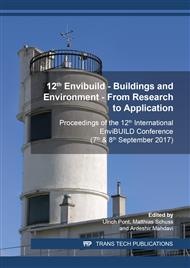p.292
p.303
p.311
p.319
p.327
p.335
p.344
p.353
p.361
BIM-Based Material Passport (MP) as an Optimization Tool for Increasing the Recyclability of Buildings
Abstract:
Building stocks and infrastructures are representing the largest material stock of industrial economies, whereby the largest fraction of building materials is transformed into waste at the end of the life cycle. In order to optimize the recycling potential of buildings, new design-tools and methods are required, whereby it is of utmost importance to have a documentation of the material composition of buildings. In this paper, the methodology for creating a BIM-based Material Passport, enabling optimization of the design of buildings and serving as a documentation of materials existing in buildings, is described. Therefore, a specific building component - the flat roof - of a residential building is used in order to test the proposed tool-chain and show the recycling potential of the built-in materials. Thereby, the recycling potential of a version in timber construction and a version in concrete construction is assessed. The results show that the two versions have a similar recycling rate. However, concrete has a significantly higher mass in comparison to timber, by what the mass of the total waste materials is less in the timber version.
Info:
Periodical:
Pages:
327-334
Citation:
Online since:
January 2019
Authors:
Keywords:
Price:
Сopyright:
© 2019 Trans Tech Publications Ltd. All Rights Reserved
Share:
Citation:


